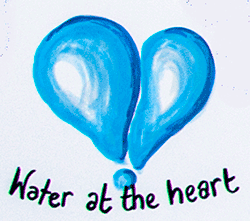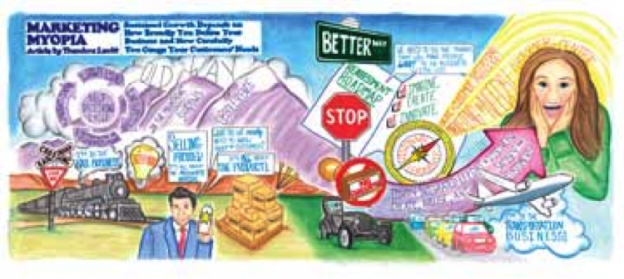A Fresh Look at “Marketing Myopia” Graphic recorder Stephanie Crowley depicts the central themes of the classic 1960 HBR article by Ted Levitt.
by Daniel McGinn and Stephanie Crowley
Text by Daniel McGinn; illustration by Stephanie Crowley
For a big client meeting in April, Accenture senior manager Mark Papia hired a type of practitioner he’d never encountered before: a “graphic recorder.”
During the session, artist Julie Stuart drew large murals depicting the participants’ discussion on 4-foot-by-8-foot sheets of paper. The goal: to help people make connections and better recall key points. “The artwork generated a tremendous amount of interaction,” Papia says.
Graphic recording—also called visual facilitation—has been around since at least the 1970s, when it was popularized by a group of San Francisco architects. It’s grown lately, driven in large part by PowerPoint fatigue. The wall-sized depictions can be captured digitally and distributed widely by e-mail, and serve not just as meeting summaries that get stuffed in folders but also as visual references for key goals or processes. “I want somebody who hasn’t been in the conversation to be able to look at something I’ve done and quickly digest the key points,” says San Francisco artist Bree Sanchez.
Does It Work?
Professor Martin Eppler of the University of St. Gallen in Switzerland has studied how well visual representations boost recall. He found that graphic recording trumps PowerPoint slides, particularly if people feel invested in the drawings. “You remember best what you’ve created yourself,” Eppler says. With PowerPoint, presenters make the slides in advance; it’s not interactive or participatory. With graphic recording, all participants actively contribute ideas to the image, so they feel that their hands are in it.
However, Eppler’s research suggests that software programs that let participants create their own visual representations—Let’s Focus or SmartDraw, for instance—may be more effective than a pricey artist’s handiwork. (Experienced professionals charge from $1,000 to $3,500 a day.)
What Companies Say
Companies using the technique include HP, Dell, S.C. Johnson, and Charles Schwab. Kraft Foods has been utilizing graphic recording in its leadership training program since 2005. “For me, the drawings are really a trigger,” says Nicole Polarek, associate director of organizational development. “I can look at the picture and remember the conversation.” Jason Dirks, Kraft’s director of training, says graphic recording keeps people interested and engaged on two levels. “You have this initial ‘wow’ factor while watching this person draw the image,” Dirks says, and afterward people can study the depiction more closely. “The artists are able to capture a lot of depth.”


